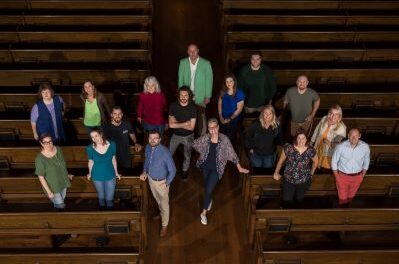Brevard Music Center’s intimate Searcy Hall was sold out for a recital by violinist Maria Sampen and faculty collaborators. This was my first opportunity to hear Ms. Sampen in recital, after having long admired her string technique from afar, watching her in the BMC Festival Orchestra. Her free-moving confident full-bow playing provided a splendid sound throughout this recital. We were treated to three fine twentieth-century works and a short piece by Mozart. For the first half of the recital, Ms. Sampen was joined by Deloise Lima, piano. Alistair MacRae, cello, was her collaborator for the single work on the second half.
Erich Korngold was already noted as a classical composer in Vienna before moving to Hollywood in 1938, where he became one of the finest film composers of the era. Quite early in his Vienna career, Korngold composed incidental music for a staging of Shakespeare’s Much Ado about Nothing. Out of this music, he arranged a four-movement Suite for violin and piano, Op. 11. In the second movement, a burlesk entitled “Dogberry and Verges,” the staccatos and pizzicatos were exquisitely coordinated. The third movement “Scene in the Garden” was highly romantic, reminding this listener of Franz Lehar, only better. The final movement is a frenetic hornpipe.
Wolfgang Amadeus Mozart’s Adagio in E, K. 261, is scored for solo violin, two flutes, two horns and strings, and was originally composed as a replacement movement to be used in Mozart’s Violin Concerto No. 5. Played with piano accompaniment rather than orchestra, it was an interesting snippet. The performance would have benefited by more dynamic contrast; the entire Adagio was presented at a volume somewhere between forte and fortissimo.
Igor Stravinsky’s Divertimento for violin and piano was constructed by the composer out of his ballet score for The Fairy’s Kiss. It is an homage to Tchaikovsky, using as some of the source material obscure early pieces by that composer. To me, the style of this four-movement suite is reminiscent of that of Stravinsky’s Histoire du Soldat, written ten years earlier, but there are moments when the influence of Tchaikovsky shows through. Early on, one hears long melodic lines that sound like the older composer, while later there are the sudden fierce mood shifts that Stravinsky does so well. Saccharine passages alternate with angularity, and the performers managed the transitions with aplomb.
The sole work on the second half was Zoltán Kodály’s Duo for violin and cello, Op. 7. Just as he did a year later in his Sonata for unaccompanied cello, Op. 8, Kodály tapped his extensive experience as an ethnomusicologist and used folk songs and children’s songs as his base material. The songs were collected and recorded by Kodály and Béla Bartók in Transylvania, that region in the Carpathian Mountains that links Romania to Hungary. In many cases, the folk songs have irregular rhythms, reflecting the cadences of speech. The children’s songs tend to be most regular, such as the repeated-note cello theme at the beginning of the third movement. There are moments in the adagio when the violin provides an almost-human cry above a drum beat on the cello.
Doing justice to works as complex as the Kodály Duo takes artists who are not only talented on their instruments but also scholars of the music. In Ms. Sampen and Mr. MacRae, we were blessed with that talent. I have read that Ms. Sampen is a noted advocate for new music. Her performance of the Kodály Duo makes me look forward to future concerts in which we may be lucky enough to hear some of the contemporary works that she also loves.











